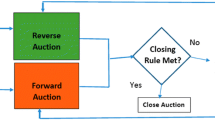Abstract
Over the last decade the growth of mobile telecommunications market has been very rapid. The technological changes have caused a drastic cost reduction and a rising differentiation in the supply of services. The Italian mobile telecommunications market is forecast to grow from about 22 million users in 1999 to an estimated 42 million in the year 2003. Currently four network operators, Telecom Italia Mobile (TIM), Omnitel Pronto Italia (OPI), Wind and BLU, share the market. The model introduced in this paper can be used to estimate the effects of a new entrant carrier in terms of profits, final prices and market share among the competitors. The proposed model through the construction of a pattern representing the considered production system allows the evaluation of the impact of carriers tariff policies in terms of final consumer prices. Such model may be useful to highlight regulatory considerations and understand relevant features related to the structure of the mobile telephony industry.
Similar content being viewed by others
References
Basar, T. and G.J. Oldser. (1995). Dynamic Noncooperative Game Theory. London: Academic Press.
Cricelli, L., M. Gastaldi, and N. Levialdi. (1999). “Vertical Integration in International Telecommunication System.” Review of Industrial Organization 14, 337-353.
Cricelli, L., M. Gastaldi, and N. Levialdi. (2001). “Strategic Behaviours in International Telecommunications System.” International Journal of Production Economics 69, 141-149.
Doyle, C. and J.C. Smith. (1998). “Market Structure in Mobile Telecoms: Qualified Indirect Access and the Receiver Pays Principle.” Information Economics and Policy 10, 471-488.
Economides, N. (2000). “US Telecommunications Today, April 1999.” In Handbook of IS Management 2000. Carol V. Brown, ed., Boca Rotan, FL: Auerbach/CRC Press.
Fintech Mobile Communications. (1997). Mobile Communications International and Company Reports.
Hocking, L. (1997). Optimal Control, an Introduction to the Theory with Applications. Oxford: Clorendon Press.
International Data Corporation Italia. (1999). Analisi del mercato ICT.
Laffont, J.J and J. Tirole. (2000). Competition in Telecommunication. Cambridge, Massachusetts: MIT Press.
Lancaster, K. (1997). Mathematical Economics. New York: Dover Publications.
Locatelli A. (1997). Elementi di Controllo Ottimo. Rozzano Milano: Citt`a Studi.
Luenberger, D.G. (1978). Introduction to Dynamic Systems Theory, Models, and Applications. New York: Wiley.
OECD. (1996). Mobile Cellular Communications: Pricing, Strategies and Competition. Paris, France: Organization for Economic Cooperation and Development.
Viscusi, W.K., J.M. Vernon, and J.E. Harrington. (1997). Economics of Regulation and Antitrust, 2nd edn. Cambridge, Massachusetts: MIT Press.
Author information
Authors and Affiliations
Rights and permissions
About this article
Cite this article
Cricelli, L., Gastaldi, M. & Levialdi, N. The Impact of Competition in the Italian Mobile Telecommunications Market. Networks and Spatial Economics 2, 239–253 (2002). https://doi.org/10.1023/A:1019911310914
Issue Date:
DOI: https://doi.org/10.1023/A:1019911310914




